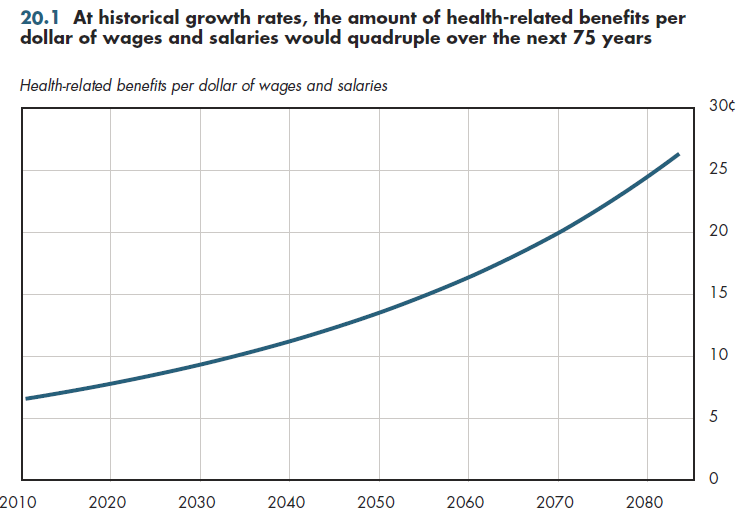Download PowerPoint versions of figure.
Inside Collection (Book): American Health Economy Illustrated
20.1 Projected Growth in Health-Related Benefits
Summary: Over the next 75 years, health benefits as a share of worker compensation could more than quadruple. Despite this, real cash wages per worker will be 7.5 times as much as the amount in 2008.
If current trends continue, the ratio of health-related fringe benefits to worker wages will more than quadruple. Admittedly, forecasting over a 75-year period is challenging. However, estimates of what wages will be through 2083 use the identical assumptions about growth in real (inflation-adjusted) wages per worker that are embedded in the most recent projections from Social Security trustees. Assuming that changes in these shares mirror what has happened during the past 10 years, the share of total compensation for health benefits and non-health fringe benefits can be projected,.
Using these simple assumptions, the ratio of health-related supplements per dollar of wages would grow over 75 years from 6.4 cents in 2008 to 26.3 cents (figure 20.1). Even after taking into account the growth in non-health fringe benefits as a share of compensation—projected in a parallel fashion—the amount of real cash wages will grow considerably, relative to 2008. That is, in terms of constant purchasing power, workers in 75 years will have nearly eight times as much non-health compensation as they received in 2008.

Succinctly, even though employers will have to devote a growing share of compensation to health care, these costs currently are not growing so rapidly that they will entirely displace the parallel (though slower) growth in real wages. Such a time might come, but not in the foreseeable future.
Downloads
References
- Department of Commerce. Bureau of Economic Analysis.
Collection Navigation
- « Previous module in collection 19.15 The Challenge of Comparing US States
- Collection home: American Health Economy Illustrated
- Next module in collection » 20.2 Technology Has Been a Key Driver of Health Spending Growth
Content actions
Give feedback:
Download:
Add:
Reuse / Edit:
Twin Cities Campus:
- © 2012 Regents of the University of Minnesota. All rights reserved.
- The University of Minnesota is an equal opportunity educator and employer. Privacy
- Last modified on Sep 24, 2013 3:21 pm -0500









